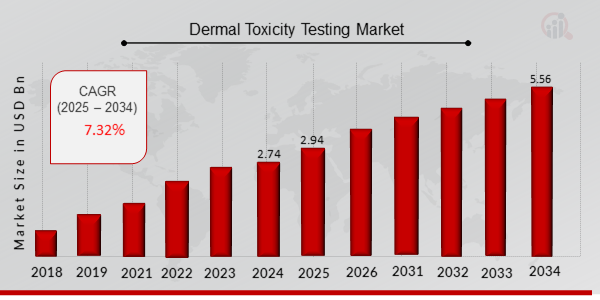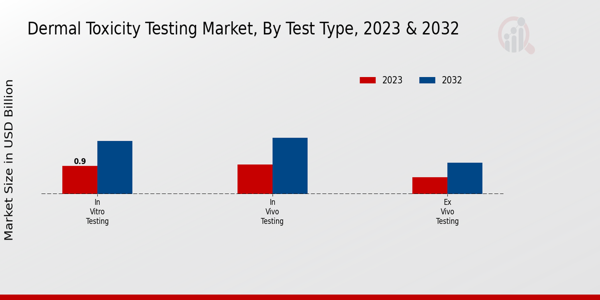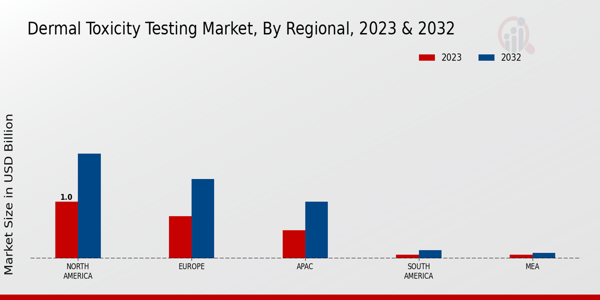Dermal Toxicity Testing Market Overview
As per MRFR analysis, the Dermal Toxicity Testing Market Size was estimated at 2.74 (USD Billion) in 2024. The Dermal Toxicity Testing Market Industry is expected to grow from 2.94 (USD Billion) in 2025 to 5.56 (USD Billion) till 2034, at a CAGR (growth rate) is expected to be around 7.32% during the forecast period (2025 - 2034).
Key Dermal Toxicity Testing Market Trends Highlighted
The Dermal Toxicity Testing Market is driven by an increasing focus on safety and regulatory compliance in the cosmetic and pharmaceutical industries. As consumers become more aware of product ingredients and their potential side effects, companies are compelled to invest in reliable testing methods. Additionally, advancements in alternative testing methods, such as in vitro and computer modeling, are reshaping the landscape. These methods not only improve accuracy but also reduce the need for animal testing, aligning with ethical considerations and regulatory requirements. Companies are adopting these innovative approaches to ensure their products are safe for consumers while adhering to stricter regulations.There are significant opportunities within the market to explore enhanced testing methods and technologies. The demand for cruelty-free and environmentally friendly testing alternatives is increasing, presenting a chance for companies to differentiate themselves. Collaboration between research institutions and industry players can foster innovation, leading to the development of more effective testing solutions that meet market needs. Furthermore, expansion into emerging markets where safety standards are evolving can provide new avenues for growth. Companies can capitalize on these opportunities by investing in research and partnerships that lead to the creation of next-generation dermal toxicity testing solutions, addressing both current challenges and future market demands.Recent trends indicate a shift toward more integrated approaches in dermal toxicity testing. There is a growing movement towards using high-throughput screening techniques that can assess the safety of compounds quickly and efficiently. This trend is accompanied by an increased emphasis on toxicological data sharing within the industry, promoting transparency and collaboration. As new technological advancements are made, integrating artificial intelligence into testing processes is gaining traction. These developments are likely to lead to faster results, reduced costs, and improved overall accuracy in toxicity assessments. These combined efforts reflect a proactive approach to dermal toxicity testing aimed at fostering consumer trust and ensuring product safety in a competitive marketplace.

Source: Primary Research, Secondary Research, MRFR Database and Analyst Review
Dermal Toxicity Testing Market Drivers
Rising Regulatory Requirements for Safety Testing
One of the most significant drivers for the growth of the Dermal Toxicity Testing Market Industry is the increasing regulatory requirements for the safety testing of cosmetic, pharmaceutical, and chemical products. As consumer awareness regarding safety and ethical testing methods rises, regulatory bodies around the world are implementing stricter guidelines. These regulations necessitate robust dermal toxicity assessments, which are imperative for the approval and market accessibility of new products.Regulatory agencies are emphasizing the importance of dermal testing to ensure that products do not pose health risks to consumers upon skin contact. Therefore, companies are compelled to invest in advanced dermal toxicity testing to comply with these regulations, leading to substantial market growth. Additionally, regulatory shifts toward more humane testing methods bolster the demand for alternative testing methodologies, such as in vitro testing, which further energizes the Dermal Toxicity Testing Market Industry.As a consequence, businesses are focusing on developing innovative testing solutions to enhance compliance, guaranteeing both the safety of their products and the well-being of consumers. The ongoing evolution of global regulatory standards is driving a greater emphasis on dermal toxicity testing, making it a crucial component of product development and safety assurance.
Growing Demand for Consumer Safety and Product Efficacy
There is a growing demand from consumers for safety and efficacy in products applied to the skin. In the Dermal Toxicity Testing Market Industry, this demand is prompting manufacturers to prioritize thorough testing for dermal toxicity. Consumers increasingly prefer products that are verified as safe and effective, leading companies to adopt comprehensive testing protocols to confirm their product claims. This rising consumer awareness and preference push for more rigorous safety evaluations facilitate the growth of the dermal toxicity testing sector, ensuring that only the safest and most effective products reach the market.
Advancements in Testing Technologies
The rapid advancements in testing technologies, including high-throughput screening and organ-on-a-chip models, are significantly influencing the Dermal Toxicity Testing Market Industry. These innovative technologies are enhancing the accuracy, efficiency, and speed of dermal toxicity testing. Companies are increasingly adopting these advanced methodologies to reduce costs and improve timelines in product development. The availability of superior testing technologies drives the market forward as it allows for more reliable assessments of dermal toxicity, catering to the demand for high-quality safety evaluations.
Dermal Toxicity Testing Market Segment Insights
Dermal Toxicity Testing Market Test Type Insights
The Dermal Toxicity Testing Market, valued at 2.39 USD Billion in 2023, has been increasingly expanding, particularly in the context of its Test Type segmentation, which includes In Vitro Testing, In Vivo Testing, and Ex Vivo Testing. In Vitro Testing, with a valuation of 0.9 USD Billion in 2023 and projected to grow to 1.7 USD Billion by 2032, serves as a significant methodology for assessing dermal toxicity while minimizing the use of live animals, making it a favored choice for many organizations focused on ethical standards in testing.This method not only supports the growing trend of alternative testing strategies but also aligns with regulatory demands, making it an area of strong growth potential. In Vivo, Testing stands tall with a 2023 valuation of 0.95 USD Billion, expected to reach 1.8 USD Billion by 2032. This method remains crucial for comprehensive assessments involving living organisms to evaluate real-world biological responses. The capacity to observe the systemic effects of substances through In Vivo Testing provides insights that In Vitro methods may not achieve, thus maintaining its importance in the global market landscape.Lastly, Ex Vivo Testing, typically less dominant with a valuation of 0.54 USD Billion in 2023, projected to increase to 1.0 USD Billion in 2032, nonetheless plays a vital role in providing a transitional step between laboratory and in vivo studies. It utilizes excised tissues to evaluate the effects of compounds, which can offer relevant data while adhering to the ethical treatment of animals. The detailed segmentation of the Dermal Toxicity Testing Market and its diverse methodologies reflect the industry’s adaptation to technological advancements, increased regulatory frameworks, and the ethical implications of toxicological assessments while maintaining a keen focus on human safety.The growth in this sector is driven by a combination of regulatory pressures, a shift towards humane testing practices, and the demand for more accurate and applicable toxicity assessments across various industries, including pharmaceuticals, cosmetics, and chemical manufacturing. The overall segmentation in the Dermal Toxicity Testing Market showcases different testing methodologies, providing a comprehensive approach to address the diverse needs within the industry.

Source: Primary Research, Secondary Research, MRFR Database and Analyst Review
Dermal Toxicity Testing Market Product Type Insights
The Dermal Toxicity Testing Market has shown significant growth and diversification, especially within the Product Type segment. In 2023, the market valued at 2.39 billion USD showcased the increasing importance of dermal toxicity testing for safety assessments in various industries. The segmentation includes Reagents, Instruments, and Consumables, each playing a vital role. Reagents, being essential for performing tests, facilitate accurate toxicological assessments, contributing to market growth. Instruments, which include advanced testing equipment, are crucial for obtaining reliable results, further driving advancements in this sector.Consumables dominate the market due to their widespread application and necessity in routine testing processes. The growing awareness of the adverse effects of chemicals on skin health propels the demand for these product types. The expected market trends also reflect the need for innovative solutions and enhanced regulatory frameworks, which present considerable opportunities for development in the Dermal Toxicity Testing Market. As the industry evolves, evolving methodologies involving these products will continue to shape the market landscape, with promising prospects for scientific advancement and improved toxicology testing standards.
Dermal Toxicity Testing Market Laboratory Type Insights
The Dermal Toxicity Testing Market is witnessing significant growth driven by various laboratory types that play crucial roles in toxicology assessments. In 2023, the market was valued at approximately 2.39 billion USD, highlighting the increasing reliance on rigorous testing methods to ensure safety and compliance in dermatological products. Among the key laboratory types, In-house Laboratories are crucial for companies wishing to maintain full control over testing procedures and results, ensuring proprietary advantages. Contract Research Organizations (CROs), on the other hand, are dominating the market by providing specialized expertise and cost efficiencies for biopharmaceutical companies looking to outsource their testing needs.Academic Research Institutes also represent an important facet, contributing to advancements in dermal toxicity knowledge through innovative research and collaborations with industry players. Overall, these laboratory types significantly shape the landscape of the Dermal Toxicity Testing Market, with trends toward outsourcing and reliance on technological advancements aiding market growth. The demand for effective and reliable testing methods continues to propel investments in these laboratories, further enhancing their roles in the industry.As regulatory requirements tighten, the necessity for accurate and extensive data from these segments remains paramount.
Dermal Toxicity Testing Market End Use Insights
The Dermal Toxicity Testing Market is poised for notable growth, valued at 2.39 USD Billion in 2023 and projected to reach 4.5 USD Billion by 2032, reflecting the rising need for safety assessments across various industries. The segmentation based on End Use showcases significant demand from the Pharmaceuticals sector, which regularly requires comprehensive toxicity testing to ensure product safety. Meanwhile, the Cosmetics industry emphasizes similar methodologies to validate the integrity of their personal care products, thereby driving a substantial portion of the market.Chemical Manufacturing also plays a crucial role in this landscape, as adherence to regulatory requirements necessitates thorough dermal testing protocols to maintain compliance and safeguard user health. Additionally, Biotechnology is increasingly focusing on innovative testing methods, leading to advancements in dermal toxicity assessments that further propel market dynamics. Overall, these segments significantly contribute to the Dermal Toxicity Testing Market revenue, highlighting a robust interconnection between product innovation, regulatory demands, and consumer safety awareness in the market growth landscape.
Dermal Toxicity Testing Market Regional Insights
The Dermal Toxicity Testing Market demonstrates significant growth across its regional landscape, valued at 2.39 USD Billion in 2023 and projected to evolve robustly by 2032. North America leads this regional segmentation, holding a prominent position with a valuation of 1.0 USD Billion in 2023 and expected to reach 1.85 USD Billion by 2032, driven by a well-established pharmaceutical sector and stringent regulatory requirements. Europe follows with a substantial share, valued at 0.75 USD Billion in 2023 and anticipated to grow to 1.4 USD Billion, reflecting increased investments in toxicological research and safety evaluations.The APAC region is emerging as a significant player, valued at 0.5 USD Billion in 2023, reflecting the growing demand for dermatological products and increasing R&D activities. South America and the MEA regions, while smaller in comparison, show promise with valuations of 0.07 USD Billion and 0.07 USD Billion, respectively, in 2023, as they work towards strengthening their regulatory frameworks and fostering collaboration in the biopharmaceutical industry. Overall, the Dermal Toxicity Testing Market statistics indicate a diverse and growing landscape, with opportunities for innovation and market growth across all regions, underpinned by rising safety concerns and regulatory pressures.

Source: Primary Research, Secondary Research, MRFR Database and Analyst Review
Dermal Toxicity Testing Market Key Players and Competitive Insights
The Dermal Toxicity Testing Market is experiencing significant growth driven by increasing regulatory demands for safety assessments in cosmetics, pharmaceuticals, and chemical industries. This market is characterized by a diverse range of players, including established organizations and emerging firms focused on innovating testing methodologies and improving market offerings. Competitive dynamics are shaped by technological advancements, strategic collaborations, and a rising emphasis on reducing animal testing through the development of alternative in vitro models. The growing awareness of dermal toxicities associated with various substances is pushing companies to enhance their testing processes to meet stringent safety regulations. Overall, the competitive landscape reflects a focus on improving the efficiency and accuracy of toxicity testing methodologies while addressing the evolving needs of clients across multiple sectors.Envigo is a prominent player in the Dermal Toxicity Testing Market, known for its comprehensive range of services designed to support regulatory submissions and preclinical development. The company leverages its vast experience and expertise in in vivo and in vitro testing, providing clients with reliable and innovative solutions. Envigo's strengths lie in its high-quality laboratory facilities, adherence to industry standards, and commitment to scientific excellence. They focus on developing robust testing protocols that meet client specifications while also aligning with regulatory guidance. The company's extensive network, coupled with its strong reputation for customer service and scientific validation, positions it well in a competitive landscape that demands precision and reliability in toxicological assessment.Clinical Research Services plays a vital role in the Dermal Toxicity Testing Market, offering a wide array of specialized research services aimed at evaluating the safety and efficacy of dermal products. The company is recognized for its innovative approaches to toxicity testing, including the implementation of advanced in vitro models that enhance predictive capabilities and reduce reliance on animal testing. Clinical Research Services is committed to providing high-quality data and insights, allowing clients to efficiently navigate the complex regulatory environment. With a strong emphasis on scientific rigor and compliance with global standards, the company fosters partnerships to drive success in dermal toxicity research. Their ability to deliver tailored solutions and maintain a customer-centric approach has established Clinical Research Services as a respected name in the dermal toxicity testing arena, contributing to their growing presence and influence in the market.
Key Companies in the Dermal Toxicity Testing Market Include
- Envigo
- Clinical Research Services
- Medpace
- Wuxi AppTec
- Prometrika
- Eurofins Scientific
- PRA Health Sciences
- Charles River Laboratories
- inscentiv
- Celerion
- Synlogic
- Laboratory Corporation of America Holdings
- Covance
- Kforce
- Purdue Pharma
Dermal Toxicity Testing Market Industry Developments
Recent developments in the Dermal Toxicity Testing Market reflect a growing emphasis on regulatory compliance and technological advancements. Companies like Envigo, Wuxi AppTec, and Charles River Laboratories are enhancing their testing capabilities to comply with stringent regulatory demands. There have been notable mergers and acquisitions; for instance, Charles River Laboratories acquired certain assets of a leading player in the dermal toxicity space, expanding its footprint. Eurofins Scientific continues to invest in innovative testing methodologies, which bolster its market position. The valuation of organizations such as Medpace and PRA Health Sciences has seen a significant rise, driven largely by their expanding service portfolios and high demand for dermal toxicity testing. Meanwhile, initiatives to reduce animal testing have led to increased investments in alternative testing methods, further transforming the landscape. These companies are also exploring partnerships to enhance their research capabilities and develop cutting-edge solutions. The dynamics of supply and demand in the market are shaping investment strategies, with firms prioritizing research and development to maintain a competitive edge while addressing customer requirements for safety and efficacy.
Dermal Toxicity Testing Market Segmentation Insights
Dermal Toxicity Testing Market Test Type Outlook
- In Vitro Testing
- In Vivo Testing
- Ex Vivo Testing
Dermal Toxicity Testing Market Product Type Outlook
- Reagents
- Instruments
- Consumables
Dermal Toxicity Testing Market Laboratory Type Outlook
- In-house Laboratories
- Contract Research Organizations
- Academic Research Institutes
Dermal Toxicity Testing Market End Use Outlook
- Pharmaceuticals
- Cosmetics
- Chemical Manufacturing
- Biotechnology
Dermal Toxicity Testing Market Regional Outlook
- North America
- Europe
- South America
- Asia Pacific
- Middle East and Africa
| Report Attribute/Metric |
Details |
|
Market Size 2024
|
2.74 (USD Billion)
|
|
Market Size 2025
|
2.94 (USD Billion)
|
|
Market Size 2034
|
5.56 (USD Billion)
|
|
Compound Annual Growth Rate (CAGR)
|
7.32 % (2025 - 2034)
|
|
Report Coverage
|
Revenue Forecast, Competitive Landscape, Growth Factors, and Trends
|
|
Base Year
|
2024
|
|
Market Forecast Period
|
2025 - 2034
|
|
Historical Data
|
2020 - 2024
|
| Market Forecast Units |
USD Billion |
| Key Companies Profiled |
Envigo, Clinical Research Services, Medpace, Wuxi AppTec, Prometrika, Eurofins Scientific, PRA Health Sciences, Charles River Laboratories, inscentiv, Celerion, Synlogic, Laboratory Corporation of America Holdings, Covance, Kforce, Purdue Pharma |
| Segments Covered |
Test Type, Product Type, Laboratory Type, End Use, Regional |
| Key Market Opportunities |
Increased regulatory frameworks, Growth in cosmetic safety testing, Rising demand for alternative methods, Advances in in vitro technologies, Expansion of pharmaceutical research initiatives |
| Key Market Dynamics |
Regulatory compliance requirements, Growing demand for safety assessments, Advancements in testing technologies, Increasing focus on alternative methods, and Rise in cosmetic product development. |
| Countries Covered |
North America, Europe, APAC, South America, MEA |
Frequently Asked Questions (FAQ) :
The Dermal Toxicity Testing Market is expected to be valued at 5.56USD Billion by 2034.
The market size of the Dermal Toxicity Testing Market was 2.39 USD Billion in 2023.
The expected CAGR for the Dermal Toxicity Testing Market from 2025 to 2034 is 7.32%.
North America holds the largest market share in the Dermal Toxicity Testing Market with a value of 1.0 USD Billion in 2023.
The European market for Dermal Toxicity Testing is expected to grow to 1.4 USD Billion by 2032.
The market value of In Vitro Testing in 2023 for the Dermal Toxicity Testing Market was 0.9 USD Billion.
Major players in the Dermal Toxicity Testing Market include Envigo, Charles River Laboratories, and Eurofins Scientific, among others.
The projected market size of the Ex Vivo Testing segment is expected to reach 1.0 USD Billion by 2032.
The APAC region's Dermal Toxicity Testing Market is projected to grow to 1.0 USD Billion by 2032.
The Dermal Toxicity Testing Market faces challenges such as regulatory hurdles and the need for innovative testing alternatives.

















